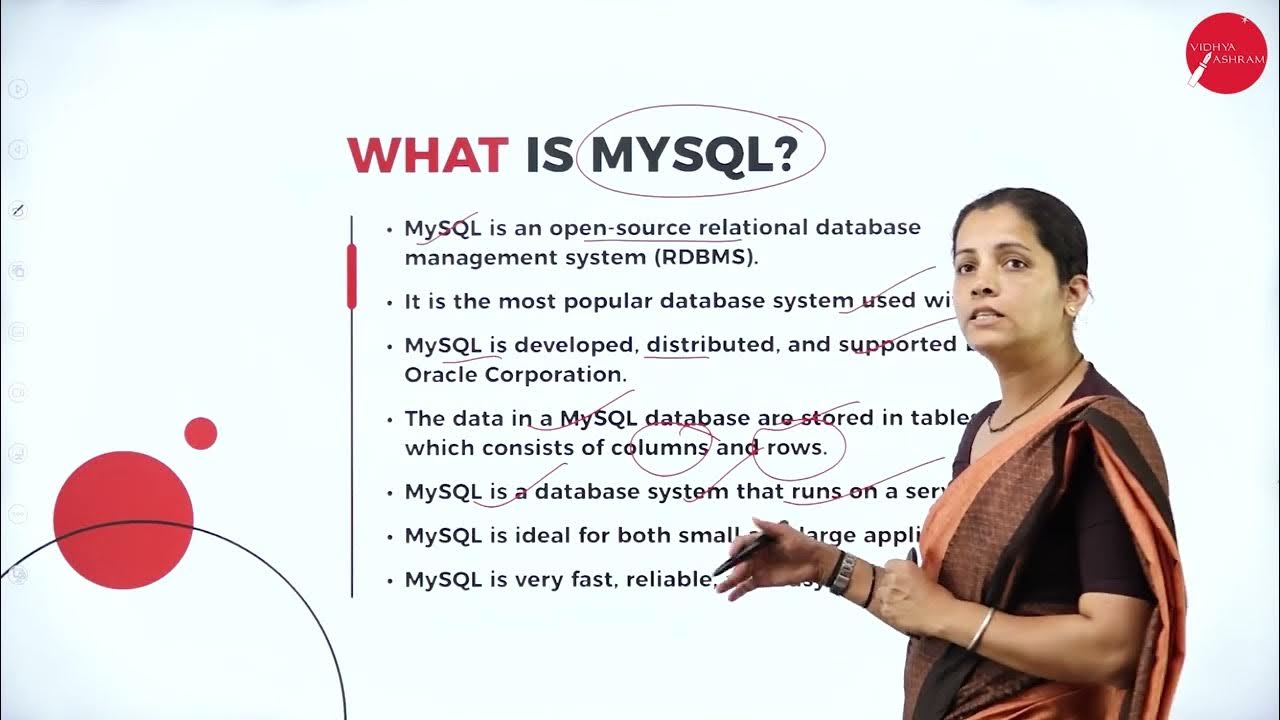1- What is Data, Database, DBMS and Types of Database | Fundamentals of Database
Summary
TLDRIn this first video of the MySQL tutorial series, Saloni introduces the basic concepts of data, databases, and their types. She explains that data refers to raw, unorganized facts, which are of no use until processed into meaningful information. A database is described as an organized collection of data, making it easier to access and manage. Saloni emphasizes the importance of database management systems (DBMS) like MySQL and Oracle. She highlights various types of databases, including relational and NoSQL databases, and touches on real-life examples of how databases are used in everyday applications like phones, social media, and online shopping platforms.
Takeaways
- 😀 Data is a collection of raw, unorganized facts or details like text, media, figures, and symbols, which by itself is not useful without processing.
- 😀 The term 'data' is derived from the word 'datum,' meaning a single piece of information.
- 😀 To make raw data useful, we need to process it into an efficient form for decision-making, such as calculating averages or determining pass/fail statuses.
- 😀 A database is a collection of data stored in an organized manner for easy access and management.
- 😀 Databases are often confused with database management systems (DBMS), like MySQL, Oracle, or MongoDB, but a DBMS is the tool used to create and manage databases.
- 😀 An analogy for understanding a database is a school registry, where details of students are stored and easily accessed.
- 😀 We use databases in everyday life, such as when selecting contacts on our phones, searching on Google, or using apps like Facebook and Instagram.
- 😀 Online shopping platforms like Amazon and Flipkart also rely on databases to manage customer, product, and transaction data.
- 😀 There are various types of databases, including relational databases (like MySQL), NoSQL databases, cloud databases, document databases, and more.
- 😀 Relational databases are one of the most common types and are widely used in interviews, especially for freshers, with SQL queries being a common topic in return tests.
Q & A
What is the meaning of 'data' as mentioned in the video?
-'Data' refers to a collection of raw, unorganized, and unprocessed facts or details. It can be in the form of text, media, figures, symbols, etc., and by itself, it doesn’t hold much value until processed into a meaningful form.
Why is raw data considered of no use until processed?
-Raw data is considered of no use because it lacks organization or context. It's only through processing the data that we can derive meaningful information, like calculating averages, determining outcomes, or making decisions.
What is a database, and how is it related to data?
-A database is a collection of data stored in an organized manner. It allows easy access and management of the data. The purpose of a database is to store data in an efficient and structured way so it can be retrieved and processed as needed.
How do people commonly misunderstand the term 'database'?
-The term 'database' is often misunderstood because people sometimes use it to refer to the database software like MySQL or Oracle. However, these are actually database management systems (DBMS), and the database itself is the container that stores the data.
What is a real-life analogy used to explain the concept of a database?
-A real-life analogy for a database is a school registry. Just like a school registry contains all the details of students in an organized manner, a database stores information in an organized fashion, making it easy to access and manage.
Can you provide examples of everyday scenarios where we use databases?
-Everyday scenarios where databases are used include selecting a contact from your phone, choosing a name from your email address book, conducting a Google search, using social media apps like Facebook and Instagram, or shopping online on platforms like Amazon and Flipkart.
What are the different types of databases mentioned in the video?
-The video mentions several types of databases, including relational databases, NoSQL databases, cloud databases, document databases, wide-column databases, and object-oriented databases.
Which type of database will be primarily used in this tutorial series?
-In this tutorial series, the primary database being used is MySQL, which is a relational database.
Why are relational databases frequently asked about in interviews?
-Relational databases are frequently asked about in interviews, especially for freshers, because they are one of the most common types used in industry. Questions about relational databases, including SQL queries, are often featured in written tests and technical interviews.
What is the difference between a database and a database management system (DBMS)?
-A database is simply a container that holds organized data, while a database management system (DBMS) is the software used to create, manage, and manipulate databases. For example, MySQL and Oracle are DBMSs that allow you to work with databases.
Outlines

Esta sección está disponible solo para usuarios con suscripción. Por favor, mejora tu plan para acceder a esta parte.
Mejorar ahoraMindmap

Esta sección está disponible solo para usuarios con suscripción. Por favor, mejora tu plan para acceder a esta parte.
Mejorar ahoraKeywords

Esta sección está disponible solo para usuarios con suscripción. Por favor, mejora tu plan para acceder a esta parte.
Mejorar ahoraHighlights

Esta sección está disponible solo para usuarios con suscripción. Por favor, mejora tu plan para acceder a esta parte.
Mejorar ahoraTranscripts

Esta sección está disponible solo para usuarios con suscripción. Por favor, mejora tu plan para acceder a esta parte.
Mejorar ahoraVer Más Videos Relacionados
5.0 / 5 (0 votes)






